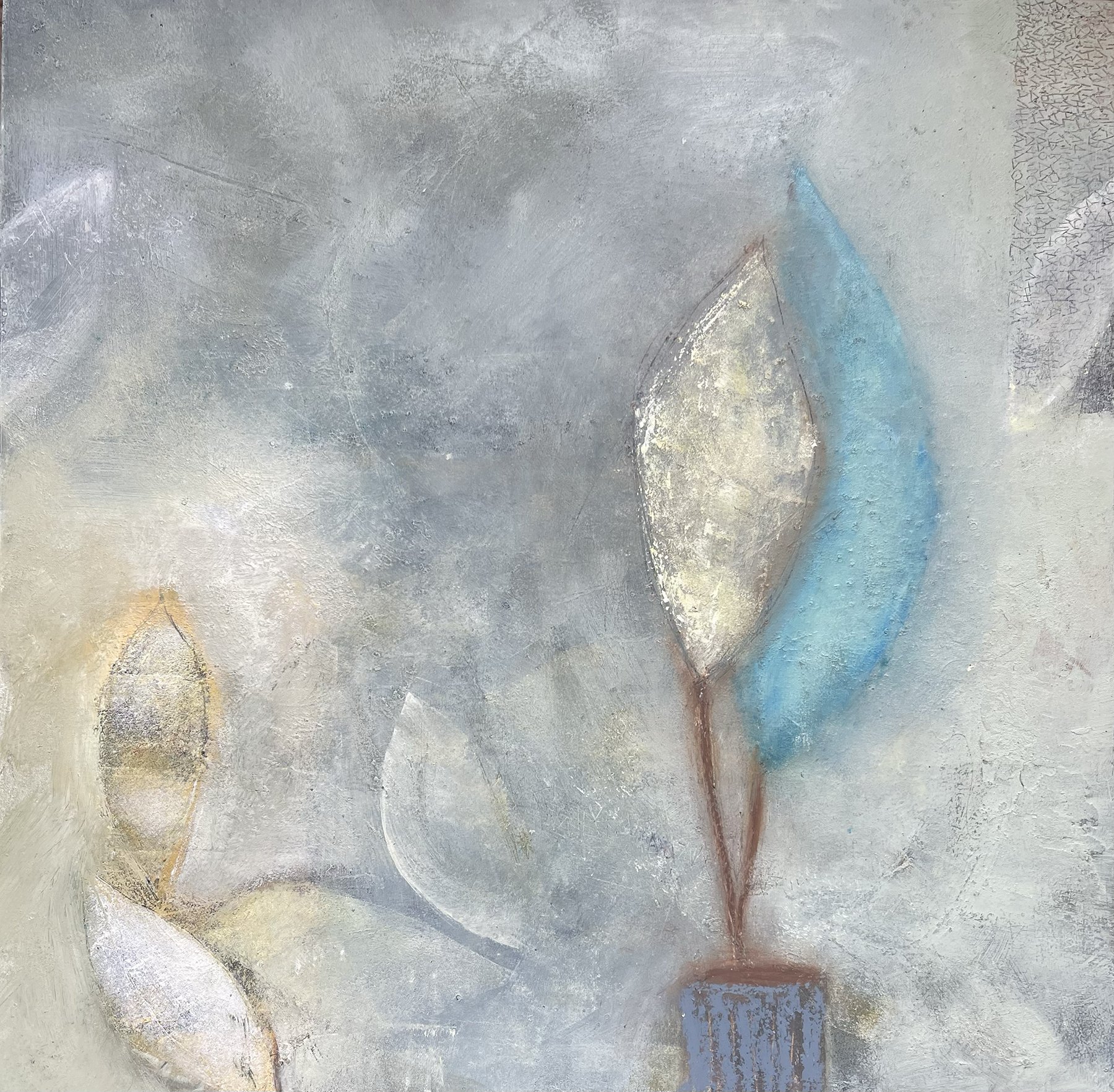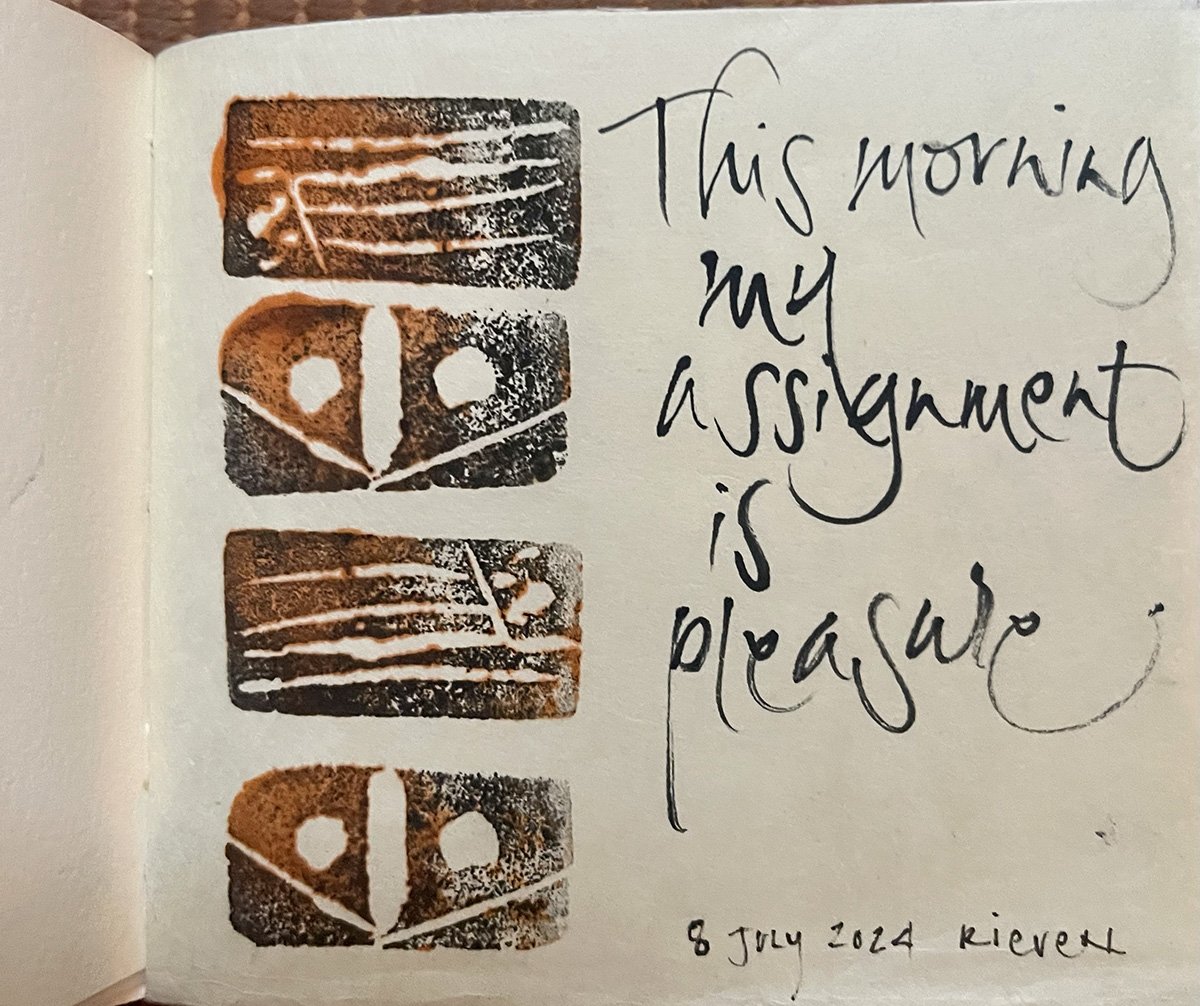
“After the final no there comes a yes”
“After the final no there comes a yes, and on that yes the future world depends.” — Wallace Stevens
Last week I wrote myself a letter and mailed it. I just got it back, and as I write this, have not yet opened it. Ok, I just opened it. What is the part of me, I wonder, that waits to open it until I am writing to you? I think it is the same part that reaches, in a myriad of ways, for the sustaining sense of otherness. But when I wrote the letter I was depending on the four-year-old me who says “write this letter as if it is from the kindest-wisest most encouraging person you know.”

Maker is both a noun and a verb
“This morning my assignment is pleasure.” I wrote this in my sketchbook today as a remedy for the many hours I have spent agonizing over a painting, or a piece of writing, or one letter. The struggle is, in part, “the nature of the beast” — the uncertainty and self-doubt involved in the decision to be a maker, the conflict of leaping ahead instead of listening to what the work wants. The shift to plowing through any conceptual road blocks and doing something is a key. But the real guide for me is to work with some tool or surface or color that gives pleasure — even if what you are looking at, as I am now, is an immense pile of imperfect paintings or a tall stack of (mostly) unpublished writing.
Over and again I'm reminded of what I know, of what you know. I mean the most important kind of knowing, the kind that gets lost when I'm busy or distracted — for example, today, remembering when I take my small sketchbook with me, when I mark something down, even one small thing in a day — how this keeps me as a plant watered, rather than wilted. How this one mark can baptize everything that happens in a day.

The Third Thing
This post is about the magic of number three, and how it applies to makers.
My online class, A Grain of Hope, just finished. We talked briefly about the numbers 1, 2 and 3 — the unity of one, the duality of two and the possibility of breakthrough with three. I will focus on three, the third thing, and give some examples, but first I want to lay the groundwork with number two:
Two brings both relationship and the trap of dualistic thinking. Two deceptions that we makers, and probably most humans, fall into are perfectionism and comparison. That is, how trying to be perfect, or comparing ourselves with others, leads to endless unresolved spirals in the mind. In this setup, we are never good enough, or even when we are, it’s only for brief moments. These mind-weeds leave no ground for the third thing. We get stuck in the thicket of good-bad, right-wrong, and pretty-ugly tangles in our mind. It is tiring. These mind-weeds stop us in the studio and at our writing desk.
What follows are some examples of puncturing duality with the third thing.

Images from “Winter Seed’s Promise”
I have just returned from a week in Taos, New Mexico, where I taught “Winter Seed’s Promise.” The students collected seeds over the winter, and also on walks on the grounds where we all stay in Taos. The seeds became images of promise, possibility, fragility, curiosity, secrets, and time. Seeds were the inspiration for writing, drawing and painting from beginning students to professionals. There was an international atmosphere in our classroom with French, Italian, American and German students.
Below are lots of images inspired by seeds, and further down is the work with alphabet variations:

“Make Your Own Bible”
Make your own Bible, is followed by this suggestion:
“Make your own Bible. Select and collect all the words and sentences that in all your readings have been to you like the blast of a trumpet.” — Ralph Waldo Emerson
This idea, along with Gerard Manley Hopkins’s idea of “inscape,” (which I will address later) is what is fueling the theme for my 2023 classes.

First Song
In the beginning, before writing, all speech was song. It is said, in the beginning was the word, and in this story, the word is a song. Even before your first breath you were given a song. Finding the note that belongs to you is a remembrance, something you have always known, but forgotten, a recognition as close to you as your own face. Something no one else has, and or will ever be again. When you hear that song, it strikes yes in your heart. You belong. Everything belongs. You mount whatever horse is waiting.
Through song, somehow all your efforts and wrong turns are rearranged into a new shape that has always been. Waiting. Grace is this intervention, the silence between notes, banishing thought. Recognizing your own place in the world, finding and being found. The song is not singing to you, but to that place inside that knows who you are.

Pause at the Threshold
I decided to take to heart this idea that the gods want to know that you are serious. What you are reaching for will be supported by your undivided attention and fervor. So I packed a suitcase and some supplies, shut down my email, and found a retreat in easy driving distance….
We aren’t alone. It is a relief when I remember that there are intelligences that are non-human. Other voices are trying to reach us, to teach us, to guide us. Sometimes I need to get away from busyness and my usual routine in order to hear. All of you have had moments when the veil briefly lifts and there is a timeless moment of clear perception. This joy, this moment of belonging to everything … isn’t that what we all reach for? And what human can take credit for this?
Envy Disguised as Compassion
Now we come to the fourth devil in the exploration of obstacles to the creative pattern and Marie Howe's poem: Magdalene– The Seven Devils. It is: envy, disguised as compassion.
I have thought about this one a lot- it is the most difficult one for me to unwrap. I was struggling with how to approach it– so I put it down. It was a Saturday, and still dissatisfied with my attempts at writing about envy, I decided to take a break to run errands. I was listening to Moth Radio Hour on NPR in my car. They were featuring stories on coincidence– all kinds of wonderful stories from listeners.

Catching Song: Teaching in Italy this Summer
I was recently listening to an interview with the musician, Bobby McFerrin where he describes improvisation as movement, as catching song. What does it mean to catch a song? It implies that the song, our creation, is already here– and so part of our work as artists is to listen, to observe, and improvise from our experience. At La Romita, we will develop these skills through drawing, writing and watercolor techniques– and taking daily sketching trips into the small Umbrian hill towns. In the afternoons we return to La Romita for time in the workshop.

Artist statement for painting exhibit at Swanson Contemporary Gallery
Painting is like poetry, an attempt to say what cannot be said.
I wish to communicate moments of fluidity between this world and the world of dreams. I want to share the sense of confirmation that happens when a dream steps right through the daytime door.
